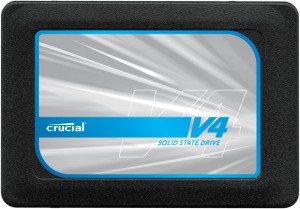 Crucial took a different route with the V4 SSD as this SATA 2 drive is driven by Phison’s PS3105-S5 controller. In retrospect, the M4 – a SATA III drive and the predecessor of the V4 – is running on Marvell 88SS9174-BLD2. The V4 is supposed to target consumers who are looking for a cheaper SSD but with similar perceived speed. This fact is is due to all SSDs having identical disk access performance.
Crucial took a different route with the V4 SSD as this SATA 2 drive is driven by Phison’s PS3105-S5 controller. In retrospect, the M4 – a SATA III drive and the predecessor of the V4 – is running on Marvell 88SS9174-BLD2. The V4 is supposed to target consumers who are looking for a cheaper SSD but with similar perceived speed. This fact is is due to all SSDs having identical disk access performance.
The V4 comes in four capacities namely, 32 GB, 64 GB, 128 GB and 256 GB. Read and write speeds vary between capacities and the maximum numbers can be achieved by the highest capacity which is in this case the 256 GB. This variant can reach a maximum sequential read speed of 230 MB/s and a maximum write speed of 190 MB/s. The maximum IOPS numbers are also achieved by the 256 GB variant, peaking at 10,000 when reading 4kbit of data randomly and 4,000 when writing.
Inside the V4 are modules of Micron 25nm synchronous MLC NAND flash memory and a DRAM cache. For those wondering how long this SSD will last, Crucial states that the V4 can save 36 Terabytes of data or approximately 20GB of data written everyday in a span of five years. Similarly, the Mean Time Between Failure (MTBF) for this device is 1 million hours. Health monitoring is achieved by the V4 SSD through S.M.A.R.T.
Specifications:
- Sequential Read: Up to 230 MB/second
- Sequential Write: Up to 190 MB/second
- NAND type: MLC
- Interface: SATA 2 3GBps
- Controller: Phison PS3105-S5
- Form Factor: 2.5 inches
- DRAM Cache: None
- Power Consumption (Active): N/A
- Power Consumption (Idle): N/A
- Warranty: 3 years
- MTBF: 1,000,000 hours
Part Numbers:
- 64GB: CT032V4SSD2
- 128GB: CT064V4SSD2
- 256GB: CT0128V4SSD2
- 512GB: CT0256V4SSD2
Reviews:
If you are looking to migrate from a hard drive to an SSD and your system is one of 90% of the SATA 2 systems out there, the Crucial V4 SSD will provide a very visible upgrade to your computer.
The Crucial V4 line is one of the few SATA II (3Gbps) drives released recently giving solid performance at a reasonable price that will appeal to those with older hardware not able to take advantage of the latest generation of SATA III (6Gbps) drives.
Was this helpful?
1 / 0